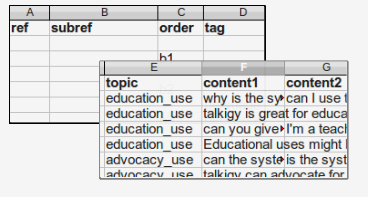The Response Bank for you automated dialogue is stored in one or more spreadsheets. Here is a quick reference to remind you of what should be entered in each column. Read this in conjunction with Creating Content.

Here are the columns that need to be included in the spreadsheets comprising the response bank, from left to right. (row 1 in the spreadsheet is ignored by the system and the column headers are simply to simplify the work of authors and editors).
ref
(col A) OPTIONAL: Not currently used.
subref
(B) OPTIONAL, ODD ROWS: Include hyperlinks here. Hyperlinks should only be used on response (odd) rows. Hyperlinks entered on even rows will be ignored
order
(C) OPTIONAL ODD & EVEN ROWS: Special commands are entered here to control talkigy's logic. For example:
- the baseline is identified here with 'b1', b2' etc.
- auto entered in here in the same row as a hyperlink entered in the subref column tells talkigy to automatically open the last URL entered in the subref column.
tag
(D) OPTIONAL ODD & EVEN ROWS: Use this column to store additional key words for the current row to make it easier for talkigy to recognise content that is entered differently from what is stored in the response bank. For example, alternate key words or occasional synonyms could be included here (see below for more info about frequently occurring synonyms). For example:
- for a stimulus "do have a branch in the UK" you might add tags "united kingdom great britain england shop outlet".
- for a stimulus "where can I find your price list", you might add the tag "pricelist" (without the space)
topic
(E) OPTIONAL, ODD & EVEN ROWS: When selecting a reply from the response bank, talkigy will favour responses occurring in a similar run of dialogue. (each run of dialogue is separated from adjacent runs of dialogue with two blank rows in the response bank spreadsheet). talkigy assumes it is more likely that a stimulus will follow on from the previous dialogue rather than be a complete change of subject. Sometimes you will want to help talkigy link stimuli and responses that are not in the same run of dialogue.
- The topic can be used to link stimuli and responses from different runs of dialogue including those stored in separate spreadsheets. In this way talkigy will tend to favour responses to stimuli where they share a topic.
- Topics should not be normal English words (normal English words will be lost amongst the other normal words used in the dialogue).
- The preferred style for a topic is either a made up word such as prod_id_45352 or two normal words joined by an underscore such as upgrades_repairs
- Topics may not include spaces (use underscore_instead)
Example topics that could link dialogue from different runs might be:
- sales_enquiries
- user_help
- investor_relations
content1
(F) MANDATORY, EXCEPT WHEN LEAVING TWO BLANK ROWS ODD & EVEN: This is where you enter your content. Stimuli you anticipate from users should be entered in even rows. Response you would like talkigy to reply with should be entered in odd rows. When there is a change of topic in the dialogue, then there should be two blank rows. When a stimulus and response is provided that is not part of a dialogue, then it should be preceded and followed by two blank rows (do not leave more than two blank rows).
Remember that stimuli may be written without punctuation and capitalisation. You may even deliberately misspell some items to anticipate errors in user input, e.g 'McDonalds', might also be referred to in stimuli as 'mac donalds' and 'mc donalds'. However, responses should be carefully written as you wish your organisation or automated dialogue to appear to the visitor.
content2, content3, content4 and content5
(G-J) OPTIONAL, EVEN ROWS: Use these columns for Stimuli on even rows only (if you enter content on odd rows it will be ignored). Enter alternative stimuli that are valid prompts for the response that comes in content1 in the next (odd) row.
More...
... on how to create your own automated dialogue.
